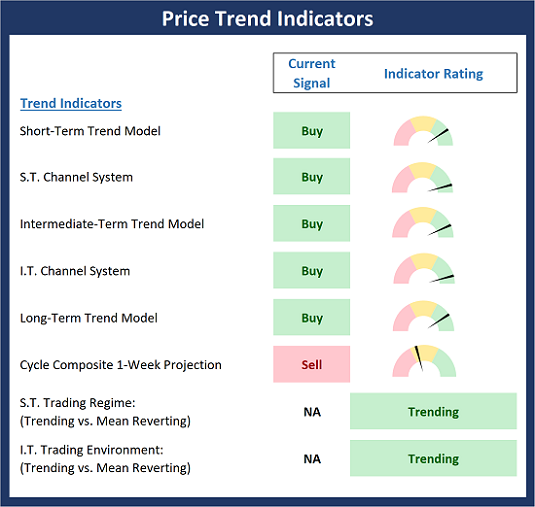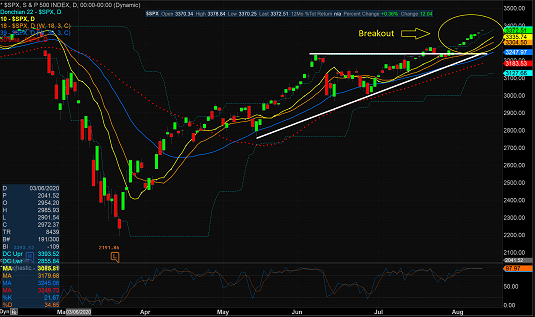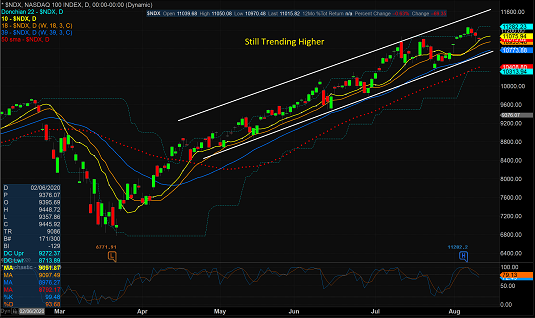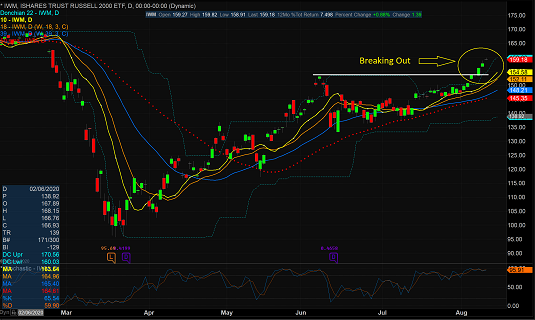Lots of Good Things Happening
The question from last week's technical review was whether or not the stock market was "breaking out" to the upside. I noted that while the S&P 500 did indeed appear to be making a run for the border, there was little in the way of confirmation from the other major indices and that even the mighty NDX (NASDAQ 100) was showing signs of being stuck in a range.
The concern was that unless we got some confirmation, stocks might be set up for the dreaded "breakout fake out" where traders try to "ride the range" by "selling the rips" and then waiting for lower prices to "buy the dips."
While we don't appear to have a table-pounding situation yet, the good news is the bulls did appear to get some all-important confirmation over the past week.
But before we get to that, let's take a look at the state of our trend board.
The State of the Trend Indicators
The Trend board indicators are designed to determine the overall technical health of the current stock market trend in terms of the short- and intermediate-term time frames.
The Trend board has backed off a smidge from last week's perfect 10.0 reading as the Cycle Composite (a mashup of the 1-year, 4-year Presidential, and 10-year decennial cycles) suggests lower prices this week. The good news is that after this week, the Cycle Composite points higher through early September - a time when the traditional "fall swoon" tends to kick in. However, given the fluidity and all the variables of the current environment, I'm taking the cycle status with a hefty grain of salt.

NOT INDIVIDUAL INVESTMENT ADVICE.
View Trend Indicator Board Online
My Take on the State of the Charts...
As I been saying for the past few weeks, one of the most positive things a market can do is to break out of a range. And as the chart below clearly shows, the S&P 500 has broken out and looks to be embarking on another up leg. And unlike last week, today I can opine that there is confirmation among the major indices as well as our momentum indicators. And the bottom line is, this is a good thing.
S&P 500 - Daily
View Larger Chart
Last week, I was concerned that the market darlings - aka the NASDAQ 100 - looked to be stuck in a range. And while the small- and mid-caps have been outperforming the NDX of late, I think we can all agree that the index remains in an uptrend. Also a good thing.
NASDAQ 100 - Daily
View Larger Chart
Speaking of good things, it is also positive that the smallcaps, as defined by the Russell 2000, looks to have broken out of its recent sideways trading range and is beginning a new uptrend. Check out the chart below.
iShares Russell 2000 ETF (IWM) - Daily
View Larger Chart
Next, let's check in on the state of the market's internal momentum indicators.

* Source: Ned Davis Research (NDR) as of the date of publication. Historical returns are hypothetical average annual performances calculated by NDR. Past performances do not guarantee future results or profitability - NOT INDIVIDUAL INVESTMENT ADVICE.
View Momentum Indicator Board Online
Once again, there is a positive change to report on the Momentum Board this week as our intermediate-term breadth thrust indicator moved up into the green zone. And with the hypothetical historical average return of the S&P 500 given the current state of the models sitting at roughly double the S&P's mean since 1980, it isn't much of a stretch to suggest that the market has some momentum behind it. Sure, I'd like to see more strength in several of the component model readings (particularly the Intermediate-Term Breadth Model). But the key is to recognize that the rally does appear to be "broadening out" and the internals are confirming. Which, of course, is also a good thing.
The Bottom Line
Given that stocks are clearly overbought and as such, ripe for some sort of a pause in what can only be described as a joyride to the upside, we shouldn't be surprised if some sort of downside testing were to occur at some point soon. But given that there is now some confirmation for the bulls to hang their hats on, I think it is best to give the uptrend the benefit of the doubt and to continue to implement a strategy of buying the dips.
Thought For The Day:
An eye for eye only ends up making the whole world blind. - Gandhi
Wishing you green screens and all the best for a great day,

David D. Moenning
Founder, Chief Investment Officer
Heritage Capital Research
Disclosures
At the time of publication, Mr. Moenning held long positions in the following securities mentioned: IWM - Note that positions may change at any time.
Trend Models Explained
Short-Term Trend Model:A series of indicator designed to identify the status of the stock market’s short-term (0-3 weeks) trend. The model compares the current price of S&P 500 relative to 5-day customized smoothing (weighted and moved forward 3 periods), the relationship of the 5-day to the 10-day, and the relationship of 10-day to 39-day.
Short- and Intermediate-Term Channel Breakout Systems: The short-term and intermediate-term Channel Breakout Systems are modified versions of the Donchian Channel indicator. According to Wikipedia, "The Donchian channel is an indicator used in market trading developed by Richard Donchian. It is formed by taking the highest high and the lowest low of the last n periods. The area between the high and the low is the channel for the period chosen."
Intermediate-Term Trend Model: A model designed to identify the status of the stock market’s intermediate-term (3 weeks to 6 months) price trend. The model compares the current weekly price of S&P 500 relative to relative to customized 10-week smoothing (weighted and moved forward 3 periods), the relationship of the 10-week to the 30-week, and the relationship of 30-week to 55-week.
Long-Term Trend Model: An indicator designed to identify the status of the stock market’s longer-term (>6 months) trend. The indicator compares the 50-day smoothing of the S&P 500 relative to its 200-day smoothing. When the 50-day is above 200-day, the indicator is positive and vice versa.
Cycle Composite Projections: The cycle composite combines the 1-year Seasonal, 4-year Presidential, and 10-year Decennial cycles. The indicator reading shown uses the cycle projection for the upcoming week.
Short- and Intermediate-Term Trading Mode Models: These indicator attempt to identify whether the current market action represents a "trending" or "mean reverting" environment. The indicator utilizes the readings of the Efficiency Ratio, the Average Correlation Coefficient, and Trend Strength models.
Momentum Models Explained
Short-Term Trend-and-Breadth Model: History shows the most reliable market moves tend to occur when the breadth indices are in tune with the major market averages. When the breadth measures diverge, investors should take note that a trend reversal may be at hand. This indicator incorporates an All-Cap Dollar Weighted Equity Series and A/D Line. At the time of this writing, when the A/D line has been above its 5-day smoothing and the All-Cap Equal Weighted Equity Series is above its 25-day smoothing, the equity index has gained at a rate of +26.5% per year since 1980. When one of the indicators is above its smoothing, the equity index has gained at a rate of +14.5% per year. And when both are below, the equity index has lost over -20% per year.
Intermediate-Term Breadth Model: A proprietary diffusion index developed by Ned Davis Research. The indicator is designed to determine the technical health of the market’s 157 sub-industry groups (GICS categorizes the market into 11 sectors, 20 industries, and 157 sub-industry groups). Technical health is determined by the direction of each sub-industry’s long-term smoothing and the rate of change of the sub-industry’s price index.
Short- and Long-Term Volume Relationship Models: These models review the relationship between "supply" and "demand" volume over the short- and intermediate-term time frames.
Intermediate-Term Price Thrust Model: This indicator measures the 3-day rate of change of the Value Line Composite relative to the standard deviation of the 30-day average.
Intermediate-Term Volume Thrust Model: This indicator uses NASDAQ volume data to indicate bullish and bearish conditions for the NASDAQ Composite Index. The indicator plots the ratio of the 10-day total of NASDAQ daily advancing volume to the 10-day total of daily declining volume. The indicator supports the case that a rising market supported by heavier volume in the advancing issues tends to be the most bullish condition, while a declining market with downside volume dominating confirms bearish conditions.
Breadth Thrust Model: This indicator uses the number of NASDAQ-listed stocks advancing and declining to indicate bullish or bearish breadth conditions for the NASDAQ Composite. The indicator plots the ratio of the 10-day total of the number of stocks rising on the NASDAQ each day to the 10-day total of the number of stocks declining each day. Using 10-day totals smooths the random daily fluctuations and gives indications on an intermediate-term basis. Historically, the NASDAQ Composite has performed much better when the 10-day A/D ratio is high (strong breadth) and worse when the indicator is in its lower mode (weak breadth). The most bullish conditions for the NASDAQ when the 10-day A/D indicator is not only high, but has recently posted an extreme high reading and thus indicated a thrust of upside momentum. Bearish conditions are confirmed when the indicator is low and has recently signaled a downside breadth thrust.
NOT INVESTMENT ADVICE. The opinions and forecasts expressed herein are those of Mr. David Moenning and Heritage Capital Research and may not actually come to pass. The opinions and viewpoints regarding the future of the markets should not be construed as recommendations. The analysis and information in this report is for informational purposes only. No part of the material presented in this report is intended as an investment recommendation or investment advice. Neither the information nor any opinion expressed constitutes a solicitation to purchase or sell securities or any investment program.
Any investment decisions must in all cases be made by the reader or by his or her investment adviser. Do NOT ever purchase any security without doing sufficient research. There is no guarantee that the investment objectives outlined will actually come to pass. All opinions expressed herein are subject to change without notice. Neither the editor, employees, nor any of their affiliates shall have any liability for any loss sustained by anyone who has relied on the information provided.
Mr. Moenning of Heritage Capital Research is an investment adviser representative of Eastsound Capital Advisors, LLC, a registered investment advisor. The adviser may not transact business in states where it is not appropriately registered, excluded or exempted from registration. Individualized responses to persons that involve either the effecting of transaction in securities, or the rendering of personalized investment advice for compensation, will not be made without registration or exemption.
Mr. Moenning and Heritage Capital Research may at times have positions in the securities referred to and may make purchases or sales of these securities while publications are in circulation. Positions may change at any time.
The analysis provided is based on both technical and fundamental research and is provided "as is" without warranty of any kind, either expressed or implied. Although the information contained is derived from sources which are believed to be reliable, they cannot be guaranteed.
The author neither endorses nor warrants the content of this site, any embedded advertisement, or any linked resource. The author or his managed funds may hold either long or short positions in the referenced securities. Republication rights must be expressly granted by author in writing.
Investments in equities carry an inherent element of risk including the potential for significant loss of principal. Past performance is not an indication of future results.

